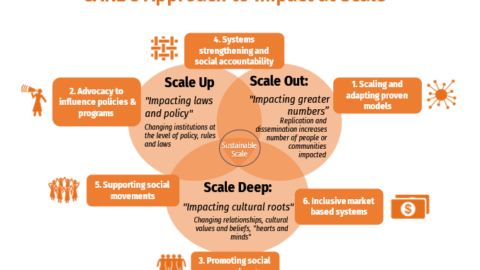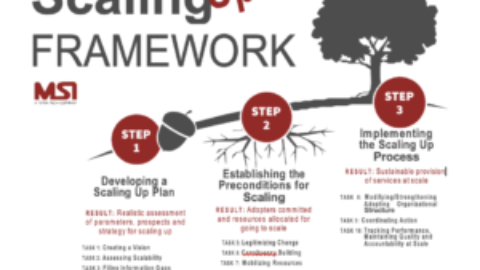By Annette Donnelly annette5@illinois.edu
The Soybean Innovation Lab (SIL) is a USAID Feed the Future program dedicated to soybean research for economic development and reduction of global poverty and hunger by accelerating growth in the agricultural sector. This multi-pronged program seeks to enhance critical aspects of the soybean value chain from field to table, by working quite literally from the research bench, to the blacksmith shop, to the kitchen counter in their pursuit of bringing high-yielding, nutritious soy to Africa. Two aspects of the SIL program primed for scalability are the Pan African Variety Trials Program (PAVTP) and our Locally-Produced Mechanization Program.
SIL 1.0 focused on research and the discovery of the obstacles and risks that were hindering success in the region. SIL 2.0 is aimed at bringing these findings to scale in collaboration with stakeholders to surmount known obstacles and initiate viable, economically feasible solutions. Looking first at the PAVTP, a critical hindrance to success in human and animal consumption of high-protein soybeans is the availability of high-yielding soybean seed to purchase in African markets. Demand from millers and oil producers is high, but local production is low, and the gap to-date has been resolved with more expensive imports. A key reason local farmers cannot meet demand is the availability of high–yield- ing soybean varieties adapted to the local climate. The PAVTP’s objective is to fast-track the identification and commercialization of new soybean varieties with higher yield and seed quality compared to the varieties currently available in Africa. This is achieved through the introduction of tens of varieties sourced from a global network of public- and private-sector partners. The program seeks to resolve the market gap with a sustainable network of transparent, formal variety trials that test a wide array of soybean varieties in the field, systematically, against a known control variety.
In the PAVTP, varieties are grown in different countries, locations and seasons and rigorously tested and monitored to determine viability. Growth rates, resistance to disease and yield are some of the plant characteristics recorded as are the size of beans and their ability to remain in the pod until harvest. SIL collaborating scientists monitor the trials and train technicians and future plant breeders on the techniques and technology for managing a world class trial. Data from the trials is uploaded into software that is sent, in real time, to SIL headquarters at the University of Illinois, Champaign for comparative analysis. The PAVTP began with collaborative trials in Kenya at 4 locations and is currently running in 53 locations across 13 countries, with more coming online shortly.
Most importantly, the trials create recommendations to register new varieties as they complete several sea- sons of testing. To date, seven new varieties have been recommended for registration in two countries. It is also interesting and encouraging to note that 34% of the PAVTP locations to date are owned by private entities. As the PAVTP expands, so does our collaborative network and we expect that the percentage of private entities will grow as move toward greater scalability.
The Locally-Produced Mechanization Program enhances economic opportunity for blacksmiths, welders, and other artisans and improves seed and grain quality for small holder producers while also reducing labor constraints. An aspect of focus for this program is mechanized threshing; it is a valuable tool because it can allow quicker removal of a crop from the field which reduces post-harvest loss in grains and cereals, and reduces losses from shattering, disease, exposure to birds and rodents and adverse weather. On many smallholder farms, mechanical threshers can replace manual threshing by hand beating, a practice that often results in grain spillage, grain breakage, and incomplete separation of the grain from the chaff. Manual thresh- ing is also a very labor and time intensive process that results in high human energy expenditure and a high rate of drudgery in the agricultural system. To help local farmers thresh crops cost effectively, the mechanization program trains local blacksmiths to build threshers with readily sourced materials. The locally built threshers are less expensive than imported small threshers and can be taken from farm, to farm with a motorbike. In SIL 1.0, designs and proof of concept were evaluated to create a training, templates and manufacturing guide for blacksmith training seminars. The trainings include business sessions so that blacksmiths can sell threshers to operators who will take threshers to local farming communities using a service-provision model. Each thresher costs under $2,000 to build and our operators tell us that it takes one season to pay off a thresher.
Mechanical threshing cuts down the time spent har- vesting crops significantly and is seen as a value-added service by farmers.
The SIL thresher training program began with one training that produced three threshers in 2016. Local blacksmiths from that class made an additional three threshers in their home shops, creating enhanced adaptations that SIL learned from and put into the designs for future training. SIL trained 22 blacksmiths in 2018 and is collaboratively partnered with ADM’s charitable arm ADM Cares and Compatible Technology International (CTI) to improve the technology and delivery model to farmers. Working collaboratively with our partners, 46 blacksmiths have been trained in both manufacturing and the business practices surrounding a successful thresher business. In 2018, an NGO work- ing with women farmers in Ghana purchased 20 threshers from SIL, which were manufactured by SIL trained blacksmiths. SIL currently collaborates with 16 different local and international entities to serve our blacksmith, operator and farmer stakeholders and we are exploring additional collaborations as of this writing.



